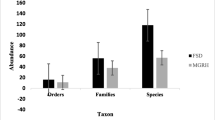Abstract
Pill-millipedes of the genus Arthrosphaera (Sphaerotheriidae) has restricted geographic distribution (Southern India, Sri Lanka and Madagascar) were under studied category of soil macrofauna. In the current study, seven morphospecies of Arthrosphaera were recovered in four biomes of the Western Ghats and west coast of India. In locations Makutta (A. fumosa), Karike (A. fumosa), Ninthikal (A. dalyi), Uppinangadi (A. magna) and Uppala (A. hendersoni) were endowed with only one species of Arthrosphaera. Although some locations consist of more than one species, one of them was dominated. Shankaraghatta forest consists of A. disticta and A. versicolor, but A. disticta was highly dominant. In Adyanadka plantations, A. magna was dominant than A. carinata. The highest number of A. disticta was recorded per quadrate in high-altitude location (Shimoga), followed by A. hendersoni in the coastal location (Uppala), A. magna (Adyanadka) and A. dalyi (Ninthikal) in foothill locations. The highest biomass of A. dalyi per quadrate was seen in Ninthikal, followed by A. magna in Adyanadka, A. disticta in Shimoga, A. fumosa in Karike and A. magna in Adyanadka and Uppinangadi. The richness of Arthrosphaera was positively correlated with biomass, conductivity, total nitrogen, potassium contents in soil and negatively correlated with calcium content in soil.



Similar content being viewed by others
References
Aerts, R. 1997. Climate, leaf litter chemistry and leaf litter decomposition in terrestrial ecosystems: a triangular relationship. Oikos 79: 439–449.
AOAC. 2006. Official methods of analysis, 18th ed. Washington DC: Association of Official Analytical Chemists.
Ashwini, K.M. 2003. Ecological studies on Indian pill millipede, Arthrosphaera magna. Ph.D. Thesis, Mangalore, India: Mangalore University.
Ashwini, K.M., and K.R. Sridhar. 2005. Leaf litter preference and conversion by a saprophagous tropical pill millipede, Arthrosphaera magna Attems. Pedobiologia 49: 307–316.
Ashwini, K.M., and K.R. Sridhar. 2006. Seasonal abundance and activity of pill millipedes (Arthrosphaera magna) in mixed plantation and semi–evergreen forest of southern India. Acta Oecologica 29: 27–32.
Ashwini, K.M., and K.R. Sridhar. 2008. Distribution of pill millipedes (Arthrosphaera) (Family: Sphaerotheriidae) and associated soil fauna in the Western Ghats and west Coast of India. Pedosphere 18: 749–757.
Attems, C. 1936. Diplopods of India. Memoirs of the Indian Museum 11: 133–167.
Branquart, É., R.D. Kime, M. Dufrêine, J. Tavernier, and G. Wauthy. 1995. Macroarthropod habitat relationships of oak forests of South Belgium. Environments and communities 1. Pedobiologia 39: 243–263.
Dangerfield, J.M. 1990. Abundance, biomass and diversity of soil macrofauna in savannah woodland and associated managed habitats. Pedobiologia 34: 141–150.
González, G., and T.R. Seastedt. 2001. Soil fauna and plant litter decomposition in tropical and subalpine forests. Ecology 82: 955–964.
González, G., R.E. Ley, S.K. Schmidt, X. Zou, and T.R. Seastedt. 2001. Soil ecological interactions: Comparisons between tropical and subalpine forests. Oecologia 128: 549–556.
Hamer, M.L. 1997. A preliminary assessment of the southern African millipede fauna: Diversity and conservation (Diplopoda). Entomologica Scandinavica 51: 209–217.
Hamer, M.L., and R.H. Slotow. 2002. Conservation application of existing data for South African millipedes (Diplopoda). African Entomology 10: 29–42.
Henegan, L., D.C. Coleman, X. Zou, D.A. Crossley Jr, and B.L. Haines. 1999. Soil macroarthropod contributions to decomposition dynamics: Tropical–temperate comparisons of a single substrate. Ecology 80: 1873–1882.
Jackson, M.L. 1973. Soil chemical analysis. Englewood Cliffs: Prentice Hall International.
Kadamannaya, B.S. 2008. Studies on pill millipedes of Western Ghats and west coast of India. Ph.D. Thesis, Mangalore, India: Mangalore University.
Kadamannaya, B.S., and K.R. Sridhar. 2009. Leaf litter ingestion and assimilation by two endemic pill millipedes (Arthrosphaera). Biology and Fertility of Soils 45: 761–768.
Kadamannaya, B.S., K.R. Sridhar, and B. Seena. 2009. Seasonal periodicity of pill millipedes (Arthrosphaera) and earthworms of the Western Ghats, India. World Journal of Zoology 4: 63–69.
Kadamannaya, B.S., K.R. Sridhar, and K.S. Sreepada. 2010. Assemblage and distribution of pill millipedes and earthworms in relation to soil edaphic features in the Western Ghats and the west coast of India. Frontiers of Agriculture in China 4: 243–250.
Meentenmeyer, V. 1978. Macroclimate and lignin control of litter decomposition rates. Ecology 59: 465–472.
Mwabvu, T. 1997. Millipedes in small-scale farming systems in Zimbabwe: Abundance and diversity (Diplopoda, Spirostreptidae). Entomologica Scandinavica 51: 287–290.
Pocock, R.I. 1899. A monograph of the pill–millipedes (Zephroniidae) inhabiting India, Ceylon and Burma. Journal of Bombay Natural History Society 12: 269–285.
Sierwald, P., and J.E. Bond. 2007. Current status of the Myriapod Class Diplopoda (millipedes): Taxonomic diversity and phylogeny. Annual Review of Entomology 52: 401–420.
Sigma Plot. 2008. Version # 11. California: Systat Soft Inc.
Smit, A.M., and R.J. van Aarde. 2001. The influence of millipedes on selected sol elements: a microcosm study on three species occurring on coastal sand dunes. Functional Ecology 15: 51–59.
Wesener, T. 2014. A new phylogenetic analysis of the Sphaerotheriida (Diplopoda) with a revision of the Australian giant pill-millipedes. Invertebrate Systematics 28: 196–213.
Wesener, T., and P. Sierwald. 2005a. The giant pill-millipedes of Madagascar. Proceedings of California Academy of Science 56: 557–599.
Wesener, T., and P. Sierwald. 2005b. New giant pill-millipede species from the littoral forest of Madagascar (Diplopoda, Sphaerotheriida, Zoosphaerium). Zootaxa 1097: 1–60.
Wesener, T., and D. VandenSpiegel. 2009. A first phylogenetic analysis of Giant Pill-Millipedes (Diplopoda: Sphaerotheriida), a new model Gondwanan taxon, with special emphasis on island gigantism. Cladistics 25: 545–573.
Wesener, T., M.J. Raupach, and P. Sierwald. 2010. The origins of the giant pill–millipedes from Madagascar (Diplopoda: Sphaerotheriida: Arthrosphaeridae). Molecular Phylogenetics and Evolution 57: 1184–1193.
Acknowledgments
The authors are grateful to Mangalore University for permission to carryout studies on pill-millipedes in the Department of Biosciences. CNA acknowledges the award of INSPIRE Fellowship, Department of Science and Technology, New Delhi, Government of India (Fellowship/2011/(294): Award # IF110540). KRS acknowledges the award of UGC-BSR Faculty Fellowship by the University Grants Commission, New Delhi, India.
Author information
Authors and Affiliations
Corresponding author
Rights and permissions
About this article
Cite this article
Ambarish, C.N., Sridhar, K.R. Pattern of Distribution of Endemic Pill-Millipedes in the Southwestern India. Proc Zool Soc 69, 229–236 (2016). https://doi.org/10.1007/s12595-015-0153-8
Received:
Accepted:
Published:
Issue Date:
DOI: https://doi.org/10.1007/s12595-015-0153-8




